July 5th, 2014 §
I hosted a little July 4 cookout yesterday, and as we were all sitting around the back porch I kept noticing unusual bird action under the azaleas next to the well house. By the end of the evening I had pretty well figured out there were baby birds involved—baby mockingbirds.
If there is any bird I associate with the farm, it’s a mockingbird. When I first moved in, I was dive-bombed and attacked by a mockingbird that had taken advantage of the abandoned property and nested in the quince by my mailbox. We had a discussion, and agreed to keep the peace. However, our detente didn’t stop any number of mockingbirds from calling all day long around the farm. They even call at night in the spring, waking me at three a.m. through open windows. Instead of being annoyed, I chose to accept and enjoy the soundtrack to life in the wilderness.
I grew to appreciate these birds more when I learned a bit about them. They were Thomas Jefferson’s favorite birds, and prized for their wide and varied song repertoire, which they add to throughout their lives. They can live to be older than a decade, and a male mockingbird can learn up to 200 songs in his lifetime. Because of their songs, mockingbirds were once prized as pets, and in the nineteenth century nearly became extinct on the East coast because of people catching them for cage birds. Even though their numbers are no longer considered threatened, they are declining.
Which is why I was thrilled to look out the kitchen window this morning and see a mockingbird swoop down as two other birds ran out from under the shadows of the azaleas. I grabbed my camera and ran out on the porch to catch this:
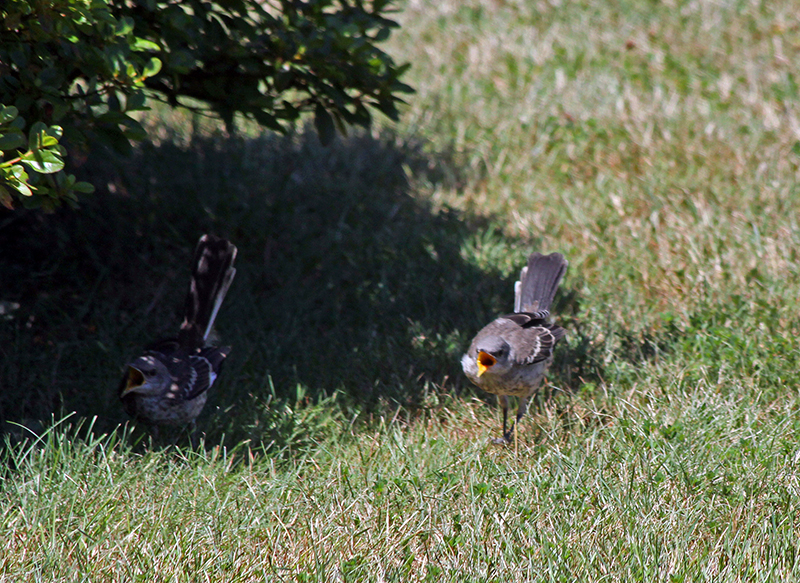
Two fledglings charged at their parent, beaks open and begging. I found it hilarious that even as chicks these birds exhibited the fearless, assertive character and stance that I’ve come to admire in adult mockingbirds.
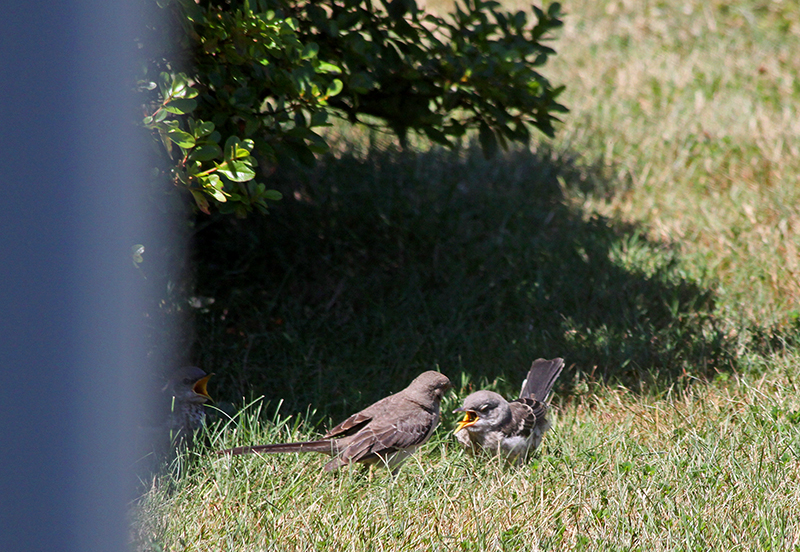
The parent fed the more self-assured chick first…

And then turned to its sibling.
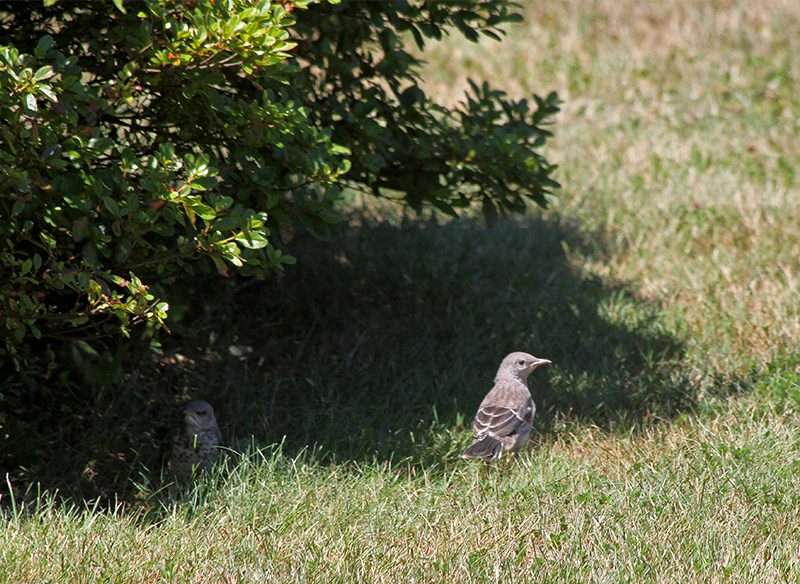
The parent then took off, just as its offspring caught wind of me and got wary, diving back under the bushes.
It was just a half-second encounter, but one of the neatest I’ve had around here. This brings the total number of bird species that I have seen reproduce in my yard this spring to five: bluebirds, cardinals, sparrows, wrens, and now mockingbirds. Sometimes it feels like I am living in a Disney movie, and I love it.
May 12th, 2014 §
Last week most of my car trips included a chirping cardboard box riding shotgun. I delivered the chicks, which hatched in March, to their new owners. The little black pullet went to an acquaintance, a Wheaten Ameraucana pullet found a new and loving home with one of my Master Gardener friends, and the four Wheaten Ameraucana cockerels sold on CraigsList within an hour. Isn’t he handsome?

I kept two pullets. One is a pure Wheaten Ameraucana (in front below) and the other is a mystery hatched from a green egg out of a black mother! I love chickens at this age—about ten weeks—because they are sweet and curious, fully feathered but still small enough to pick up with one hand. They’re like little mini chicken pocket pets.
During the day I take the pullets out of their broody coop in the garage and put them in Tucker’s old puppy crate on the grass, and they eat their fill of clover, chickweed, whatever unfortunate bug comes along, and any grubs I unearth while digging in the garden. Last night they got to try pear for the first time.
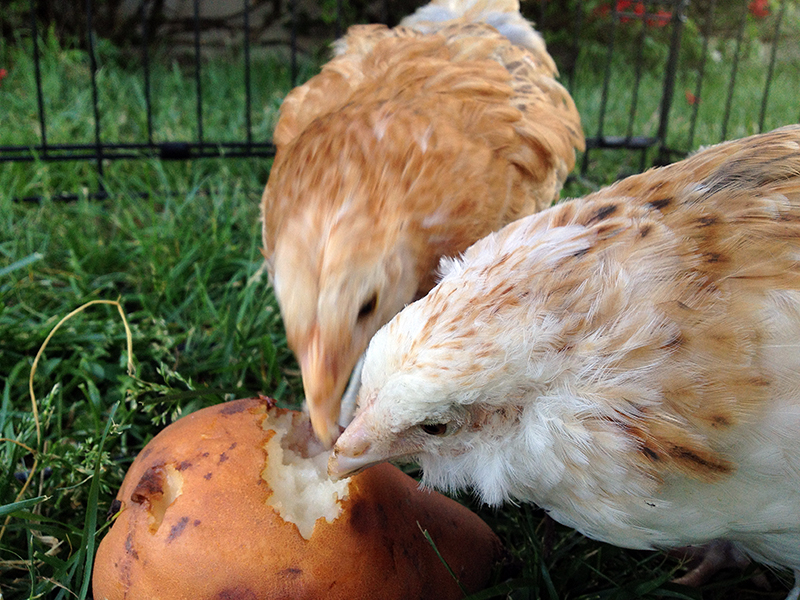

I am a bit sad that chick season is drawing to a close. If I could, I’d raise chickens all year long. I don’t think I will ever get tired of watching eggs turn into bright-eyed, beautiful birds.
Speaking of which, Mr. and Mrs. Bluebird are busy with their brood of four in the bluebird box. It’s wonderful to be back in bluebird season.

And finally, on a less joyful note, the feisty broody hen that hatched this latest batch of chicks wasn’t feisty enough when I returned her to the main flock. Despite holding her own for two days, on the eve of her third day back I found her with a quarter-size hole torn in the back of her skull. In her pain and panic to get away from her attackers she actually jumped into my arms from the nesting box. It’s the exact same wound Oregano sustained under similar circumstances, though this hen’s is worse.
She’s been getting daily Bactine spray and Neosporin plus Blue-Kote spray (which dyes her wound purple). I wish that I would have stitched her wound when I found it. She keeps knocking it open and it’s taking a very long time to heal, having to close from the outside in across basically her entire skull. In fact it’s larger now than it is in this photo, which I took a couple of weeks ago.

She doesn’t act hurt and has returned to laying eggs. As long as her wound doesn’t get infected I will just keep what I am doing and let it heal itself. My experience with Cora taught me that chickens can recover from the most dramatic wounds. This little hen is protected within another dog crate within the main coop, and will be until she heals and can successfully reintegrate with the flock.
This is what she gets for successfully raising the offspring of her sister flock mates. The injustice!
March 23rd, 2014 §
For historical record it’s worth noting that last weekend I said goodbye to Griz, the rooster hatched last summer from a well-traveled egg. Griz had been up on CraigsList for months, for free, after he predictably began challenging his father, Calabrese, in bloody fights for control of the hens. I’d separated Griz on his own in a garage coop and left him to await his fate.
Here he is on the way to his new life. He turned out to have the Cuckoo Marans coloration of his olive egger mother but the green and gold feathers came from Calabrese, his Wheaten Ameraucana father.
It’s a funny thing that he got his name from my brother, who I gave naming honors because Griz’s egg spent time in my brother’s refrigerator before being recalled to Free Union to hatch. My brother chose Grizabella as the name for this chick, which when he turned out to be a cockerel I shortened to Griz. Just the other day I was reading some British magazines and learned that “grizzly” is a term used in that part of the world to describe a chicken of this black and white barred feather patterning—something I’d never heard in America. Weird coincidence, huh?
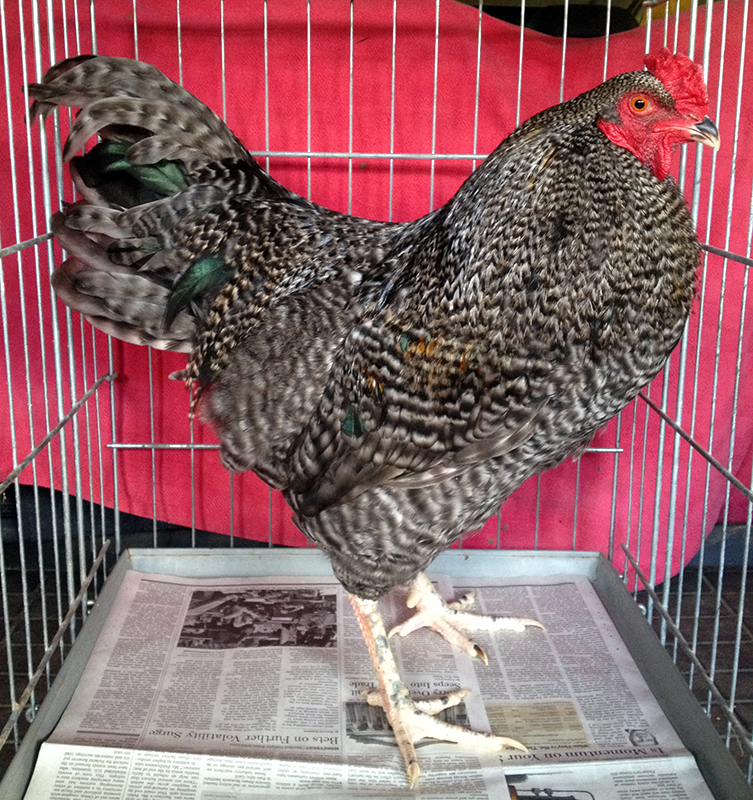
I am happy to report that Griz has gone on to a new family, who kept his name, and a flock of his own, along with a dozen of my hatching eggs. Part of the Bonafide flock will live on now in Madison, VA.
I got an e-mail from Griz’s new owner the other day:
Griz is doing well. He wasted no time on flowers when he met the ladies and they are all fast friends now. Thanks again.
I have to say I have met the nicest people in all my CriagsList chicken dealings. Maybe keeping chickens is particular to a certain personality type—who knows?—but I have always had positive experiences both buying and rehoming birds this way. It’s great to know a chick I hatched from an egg has found a good new life.
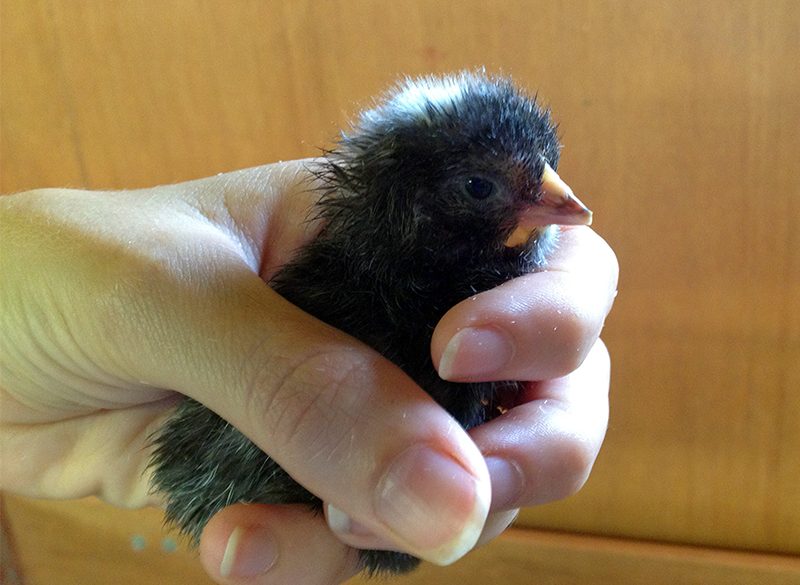
Just-hatched Griz, still damp, July 2013
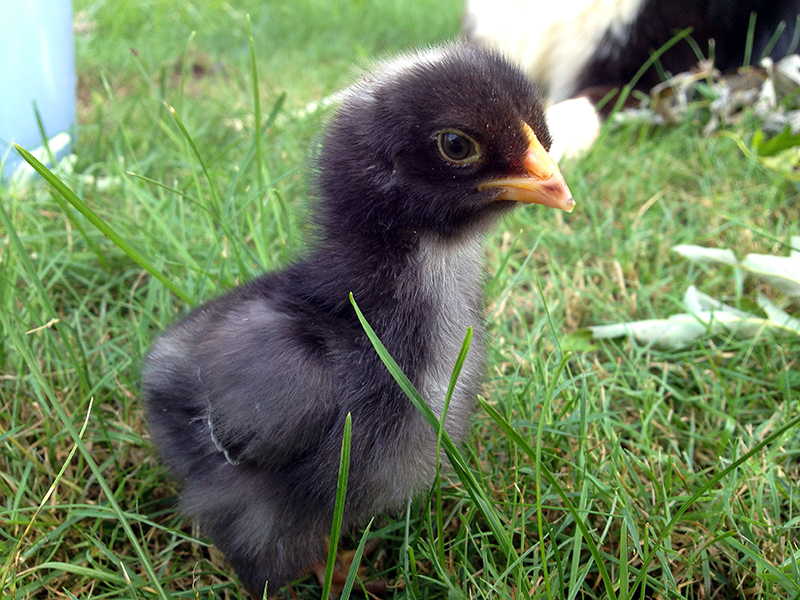
Griz at one week
March 9th, 2014 §
Tonight I snuck a peek inside some of the eggs incubating under the broody hen in the garage. It is much warmer tonight than last Sunday, so I felt comfortable taking a few photos to show you the developing chicks. Again, for a candler I just use a Mag-Light flashlight with the end duct taped but for a dime-sized hole. Here’s what the embryos look like at 14 days:
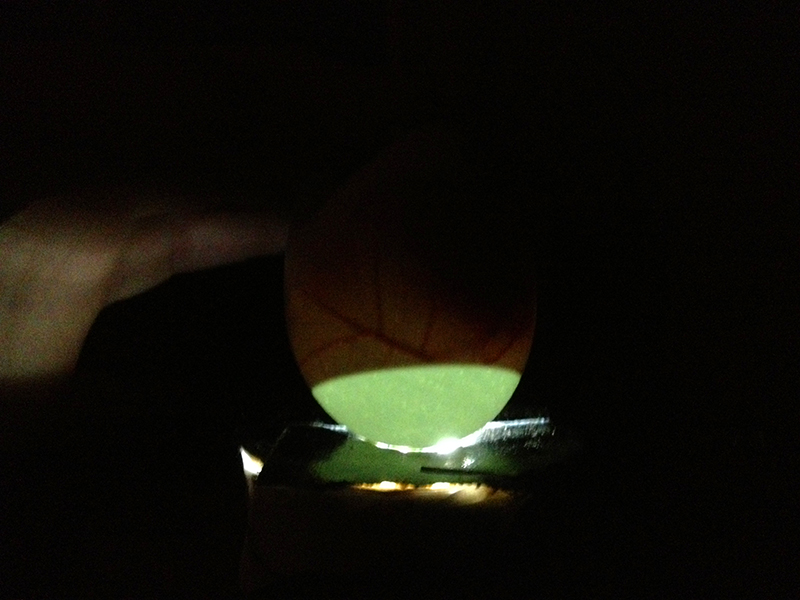
I didn’t candle all the eggs, but I did enough to determine that I have at least a few little Wheaten Ameraucanas (baby Coras) in development. The pale blue eggs are much easier to see into than brown eggs. If you want to see what the embryos look like inside at this stage, click here.

I didn’t make out too much movement, but that’s typical for this stage of development. Each embryo should soon be flipping around in its shell, pointing its head toward the rapidly-shrinking air cell (the bright, clear blue area in egg) in preparation for breaking through it with their egg tooth at hatching.
There are nine possibly viable eggs left under the hen. Props to the still-unnamed broody hen for keeping all these eggs warm during some seriously cold temperatures last week when it was well below freezing on her nest. If all continues to go well, we might have some St. Patrick’s Day chicks!
March 1st, 2014 §
Last night I drank half a glass of wine and candled the 15 eggs I’d put under a newly broody hen Sunday. What, this isn’t your idea of a rocking Friday night?
Maybe not for most people, but for me candling eggs induces Christmas-morning excitement. There are few things cooler in this world than getting to peek into an intact egg, with nothing more than a flashlight, and see bright red veins, a beating blob of heart and small dark eye. It is a magic trick, a miracle, and all those other things that make me grateful to be along for this wild ride.
Out of fifteen eggs, eight were definitely on the road to becoming chicks. One egg was a big fat question mark, and I magnanimously returned it to the clutch. I suspected five eggs were infertile, and in the interest of self education I risked destroying embryos to crack the eggs into a white bowl to check. All five were totally clear. My instinct and eye must be getting sharper.
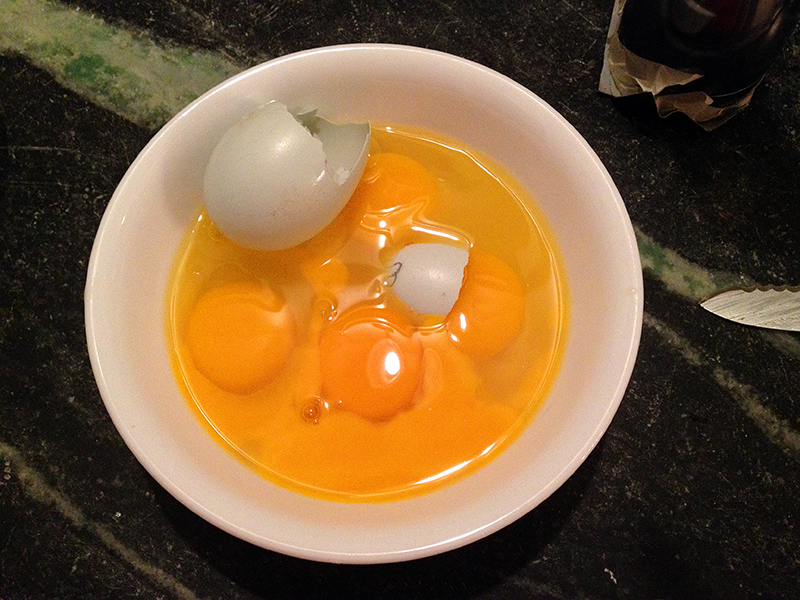
I didn’t take any photos of the developing eggs this time because I wanted them to be out in the cold air as little as possible. In fact, I withdrew them from under their mother two at a time, quickly candled them, and then snuggled them into a pan full of clean towels to hold their heat as much as possible. The whole operation was over in minutes. My pipes may have fallen victim to the polar vortex, but my potential chicks shouldn’t. If you want to see candling photos, they’re here.
I have high hopes for this hen as a broody. She’s one of last summer’s olive egger babies, and there’s a 50% chance she is Dahlia’s daughter. I only mention that because broodiness is a genetic trait. The young broody started plucking her breast feathers out a few weeks ago, and then hunkered down on all her flockmates’ eggs, hissing violently at any chicken that got too close. She’s the only broody out of the four I’ve had that’s actually pecked at me when I reached under her, and I take this feistiness as a good sign. I suppose I should name her as she’s definitely distinguishing herself.
I was on the fence about whether to do chicks again, but finally decided that it’s the best part of chicken keeping and costs me nothing. So I moved the broody to a coop in the garage, where she settled immediately despite being moved during the day, having a raucous rooster (Griz) in the coop next door, and me driving the loud and stinky tractor in and out right after the move. She remained steadfast, I set the eggs, and here we are.
I placed four eggs from my Coronation Sussex, two from last year’s olive egger babies, and nine Wheaten Ameraucana eggs from Cora under the hen. I removed all four of the Coronation eggs tonight, which were all infertile, and one Wheaten Ameraucana egg that was one of the oldest I placed, and had also cycled through the refrigerator as I waffled. I find it telling that my Coronation Sussex hen is the only bird that still has luxuriant feathers on her back and all her eggs were infertile. The hens that laid the fertile eggs are all looking a bit sparse back there because of Calabrese’s attentions. Another lesson learned—keep an eye out for “favorite” hens when scouting future mothers.
I just read back through last summer’s pained posts on hatching eggs, and I have to say that after that experience and this, I will never again let a hen set eggs in the middle of the summer. I realize now that the heat was really detrimental, leading to spoiled eggs that burst and contaminated the nest, and to chicks that were born prematurely and deformed. Incubating in the winter is the way to go. Live and learn.
But then again, we’re only five days into the 21-day incubation period, so let’s not count our chicks before they hatch, right?
September 20th, 2013 §
The chicks learned how to roost from their mother last night! Here they are when I opened the coop door this morning:

And here they are tonight around sundown, after a long day of free ranging:
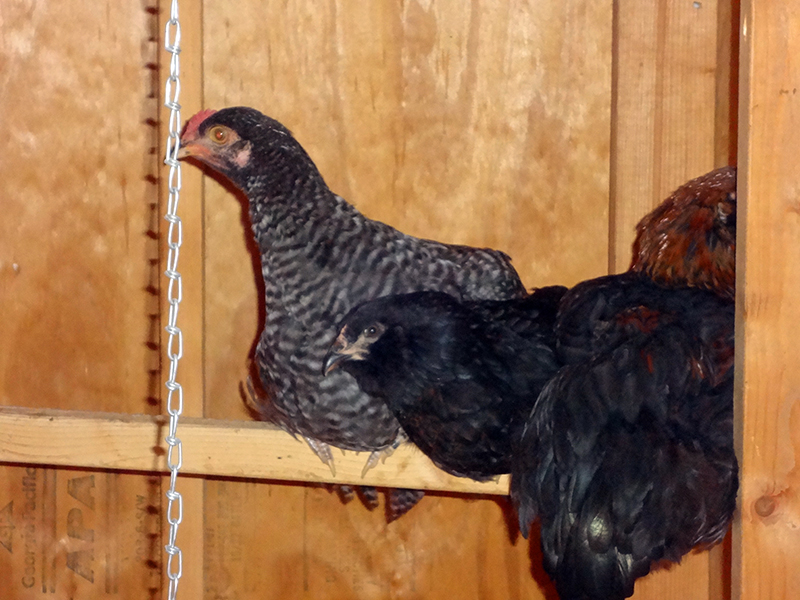
Well, at least half of them absorbed the lesson…the other three are still bedding down by the door!

September 19th, 2013 §
Last weekend I cleaned out the chicken coop, a fairly onerous task that involves a tractor, snow shovel, air compressor, dust mask and goggles. Combine all those in your head with copious amounts of airborne chicken shit dust and pine shavings and you don’t need to see any photos.
The only reward for this task, other than the agrarian nerd pleasure I take in making a hefty deposit at the compost bank, is that once the coop has aired out for a day I get to fill it will two bales of clean pine shavings, scrub out the nest box, and return the bleached feeder and waterer to their chains, full of food, and well, water. It gives me no end of pleasure to make a beautiful, clean, and healthy home for all the creatures in my care. It’s something I remember from being a kid and having all sorts of pets that needed tending. It sure wasn’t pleasant to muck out the mouse cage, or the bird cage, or the fish tank. But once it was done the joy of seeing my animals in a fresh, clean home made all that dabbling in feces and urine pretty much worth it.
And today, I feel the same way. So I cleaned out the coop, and while I was at it I decided I was tired of the growing mess that was the broody coop in the garage. The six chicks were now chickens, and they made enough mess that the tray under their coop needed emptying every three days. And, in typical messy, wasteful chicken fashion, they’d spill their food out of the feeder, and it would fall under the screen only to incubate maggots. One day when I changed the pan it was so hot I couldn’t hold my hand to it—fermentation in action! Gross, right? So while the chicks were out ranging I broke down their coop and dragged it to the driveway, where I scrubbed it with hot water and bleach. And then I cleaned out my garage, vacuuming out feather dust and sweeping away spilled food and feathers.
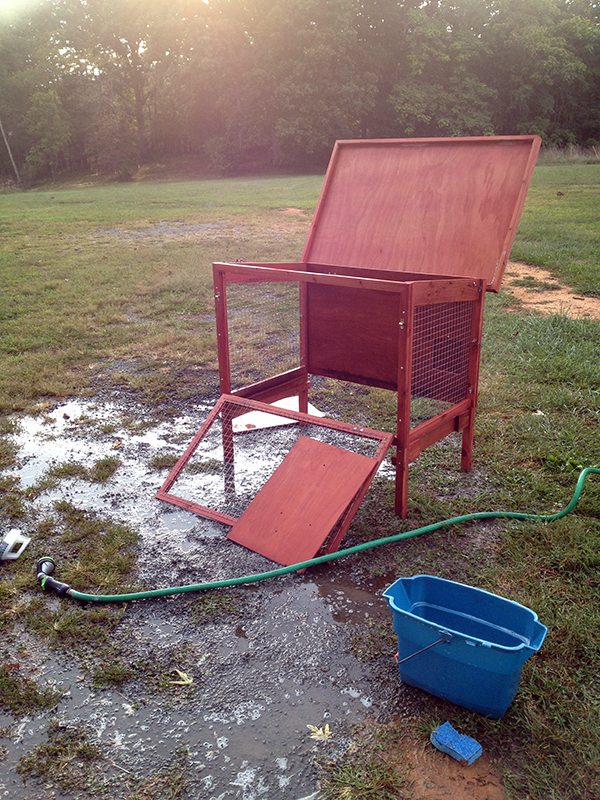
These ready-made coops were some of the best purchases I’ve ever made. They were picked up by my dad, out of desperation, for $99 each on sale at Tractor Supply, on the day the guinea babies hatched and started running out of the dog crate in which they’d been born. It seemed like an awful amount of money at the time, but they’ve paid for themselves in the use I’ve gotten out of them. I’ve used these small coops for injured birds, to separate fighting hens, for broody coops, and to raise chicks. The materials and construction are pretty cheap, and I can’t imagine them as full-time homes for any animals, but they are great for the short periods in which I tend to use them. The design is good, and I really recommend them.
Once the broody coop was drying in the sun, I set up the “annex” of the big coop to house the chicks. This is the area you first enter when you open the coop, and where I normally store the chicken food and various supplies. It has only one window, so it gets much hotter in the summer than the larger part of the coop, which has two big windows for good airflow. But now that the temperature has dropped it would be fine for the chicks.
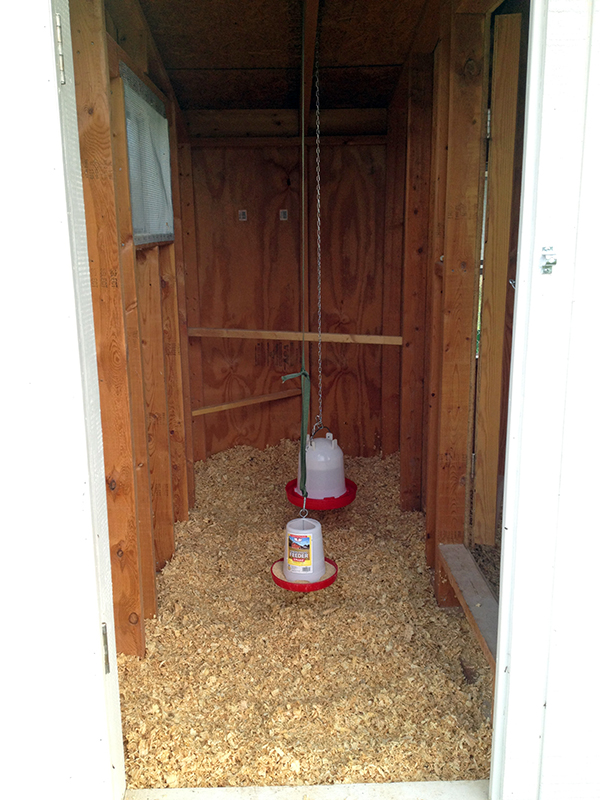
I spread pine shavings on the floor, nailed in a few roosts, and nailed up some chains to hold the feeder and waterer. Then it was all ready for the babies. Here you can see how the annex relates to the main coop. I figure it can’t hurt to have the older chickens getting used to the sounds of the chicks before I try to house them all together. It may stave off another bloody battle.
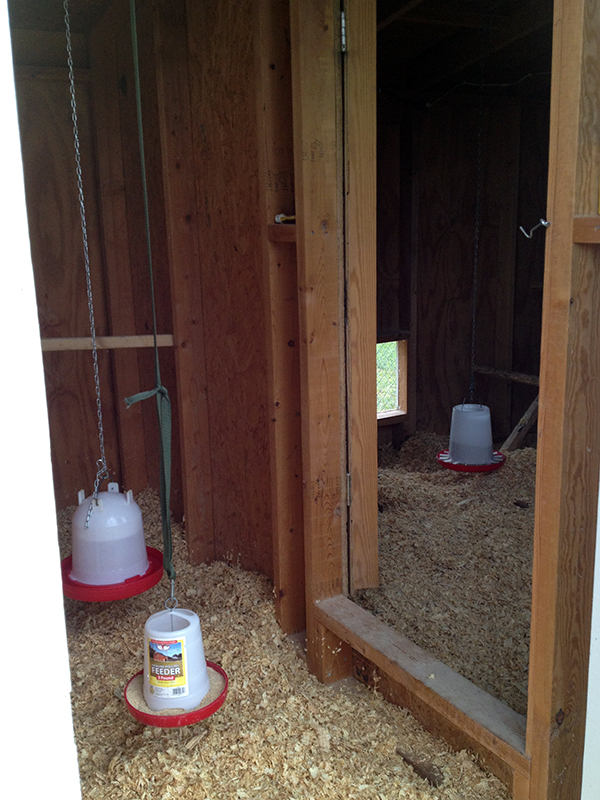
In their new home, the chicks were pretty unsure the first night. They kept trying to go back in the garage, where they’d been born. But I scooped them up and dumped them in their new home. Now, a few days later, they’ve figured out where the food is and are returning to the coop on their own in the evening. But there’s one problem: They don’t know how to roost.
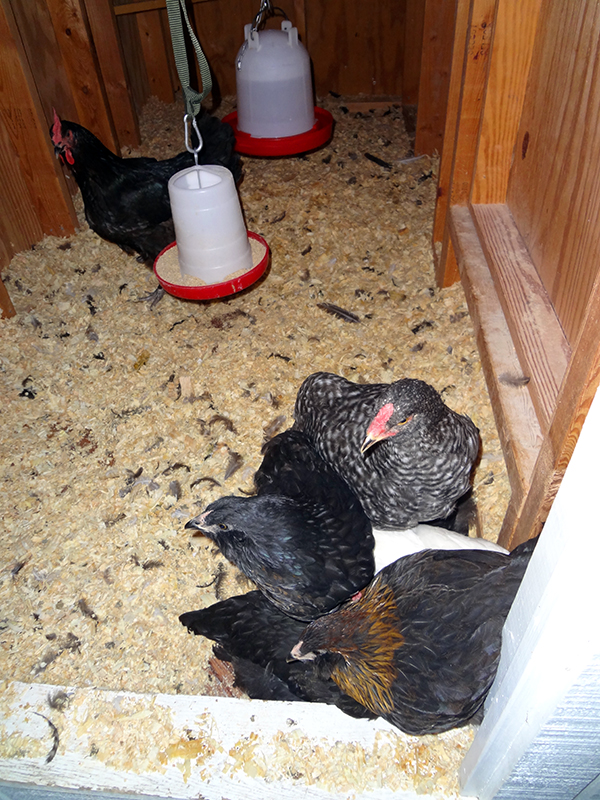
I figure that because there wasn’t a roost in their broody coop, where they lived with their mother, they never got this important chicken lesson. For the last few nights I’ve checked on them in the night, and they’re sleeping like a pile of puppies, on the ground wedged in a corner. It’s kind of adorable except that it’s really not in a chicken’s nature to sleep in a pile past the young weeks of chickdom.
So just for an experiment, tonight I caught Dahlia and put her in with her babies. That’s her above, looking at her kids like, WTF, who are you? Then, like a proper chicken she jumped on the roost to sleep. I am hoping that she will have a talk with her children and teach them how to roost. I am not super concerned—after all, chicks that aren’t raised with broody hens eventually figure out how to roost. I am more curious than anything to see if Dahlia’s behavior can influence her chicks at such a late stage in their development.
Speaking of development, this morning I awoke to Calabrese crowing, followed by his young son Griz crowing in response. This went on for a while, back and forth. I am sure my neighbors love me!
September 3rd, 2013 §
What happened to those damp little fuzzballs? Nothing remains of the chicks but their little peeping noises, which they still make when they aren’t busy practicing being grown-ups, crowing, and mating their siblings.
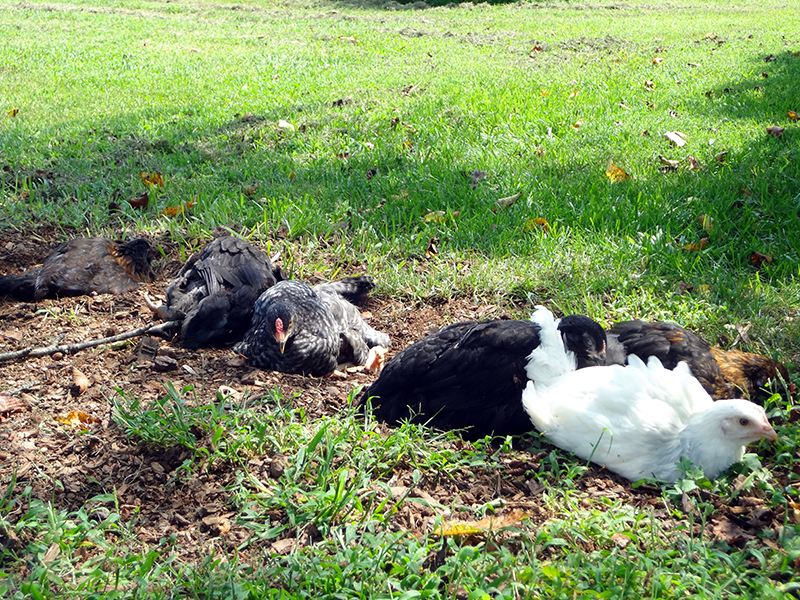
The chicks are now eight weeks old, and they are miniature chickens in most regards. This week I’ve let them find their own way out of their brooder coop and out of the garage into the wild world. They stick close to the bushes, dust bathing for hours in mulch, but each day they venture a bit further from their comfort zone. It’s wonderful to watch.
It looks like I have two cockerels: Griz, Oregano’s baby, and a Black Copper Marans/Wheaten Ameraucana mix. One thing I’ve really noticed is how much more flighty the chicks with the Black Copper Marans blood are. Makes sense, as their parent hens are the least docile of all my birds. Here’s the BCM/Wheaten Ameraucana cockerel, in front, with Griz behind, then the pretty black pullet hatched from Lilac’s egg, and finally a BCM/Wheaten Ameraucana pullet in back.
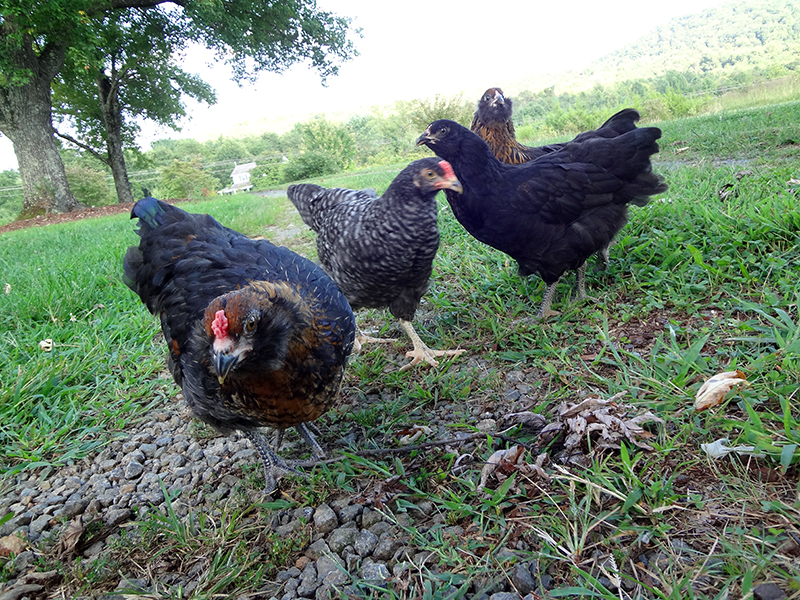
The homegrown birds all, except for Griz, have the cute facial feather tufting that comes along with their Wheaten Ameraucana blood. Interestingly, even though Griz’s father is a Wheaten Ameraucaua, he does not exhibit this feathering. Instead he looks like a straight-up Cuckoo Marans, which is blood that came from his mother’s line. So interesting to see genetics in action. Meanwhile, Griz learns just how palatable slippers are.
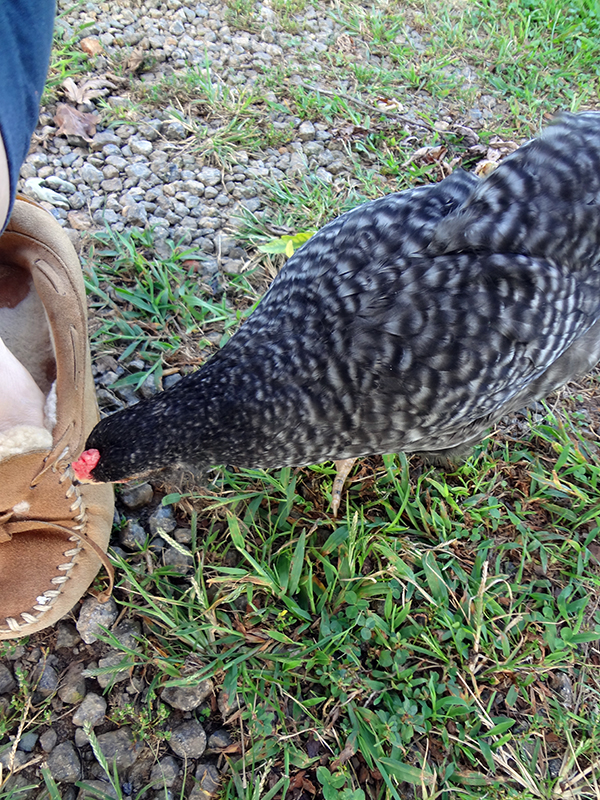
The white Coronation Sussex chick is, I believe, a pullet. Thank goodness. She is the sweetest of all six babies, always the first out of the coop and very amenable to being handled. Her lavender feathers are growing in around her head and tail, and I think she’s just so pretty. I have named her Calla.
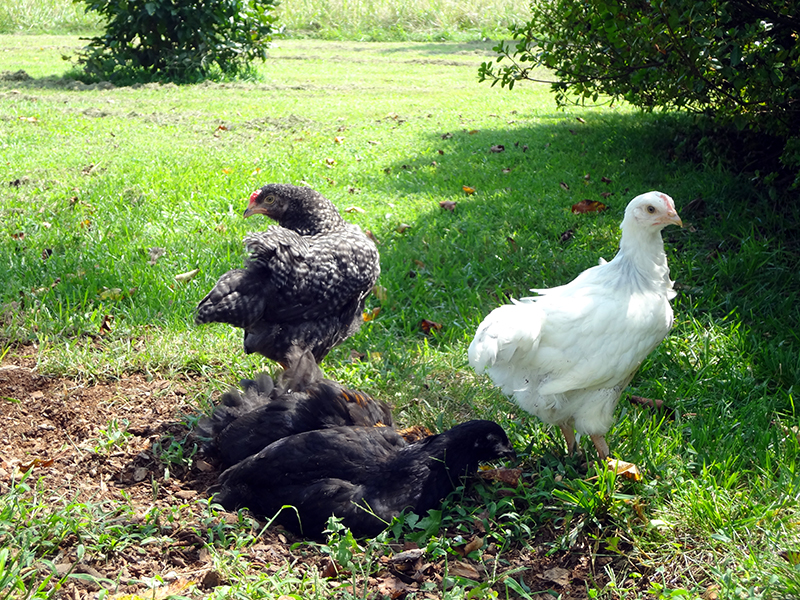
None of the other birds are named yet. I will have to see what comes to me. I also have to get Griz and the other young cockerel up on CraigsList soon. Hard to do because the birds are so cute right now—just perfect little mini chickens. But mini chickens will soon be full-blown roosters, and three on this farm is two too many.
The big chickens have met and mingled with the chicks. It’s gone okay, with the expected bullying as the older birds show the younger birds their place. Here’s Cora landing a squawk-inducing peck on a chick, while the other babies bunch up for safety and Griz tries to decide whether to be a man.

As of last night, Dahlia has rejoined her flock. It seems to be going okay for her. I bet she’s glad to be rid of these increasingly active babies in a small brooder coop.
Fifteen birds running around here is a lot, but I kind of love it. If chickens weren’t so messy, and their food so expensive, and if we didn’t have to go through winter when free-ranging isn’t as easy or safe, I would have zillions of chickens.
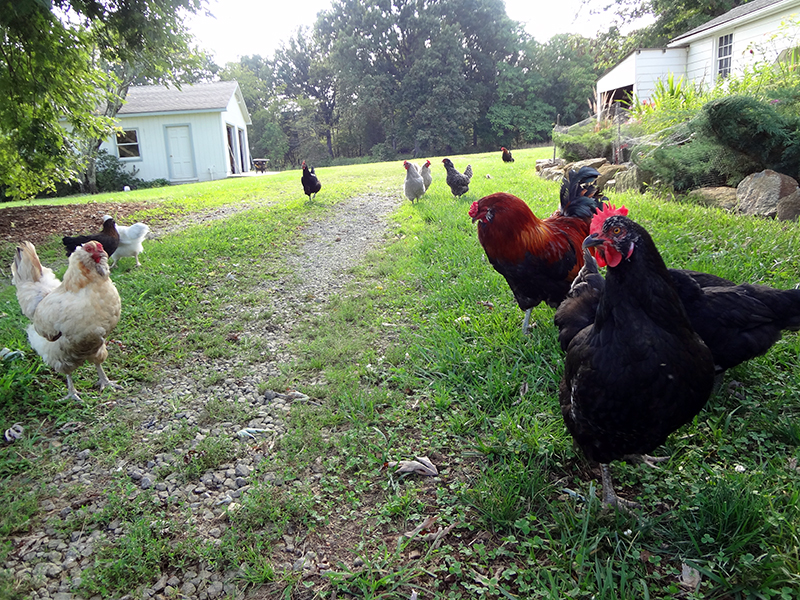
July 29th, 2013 §
“Stop looking at her butt!”
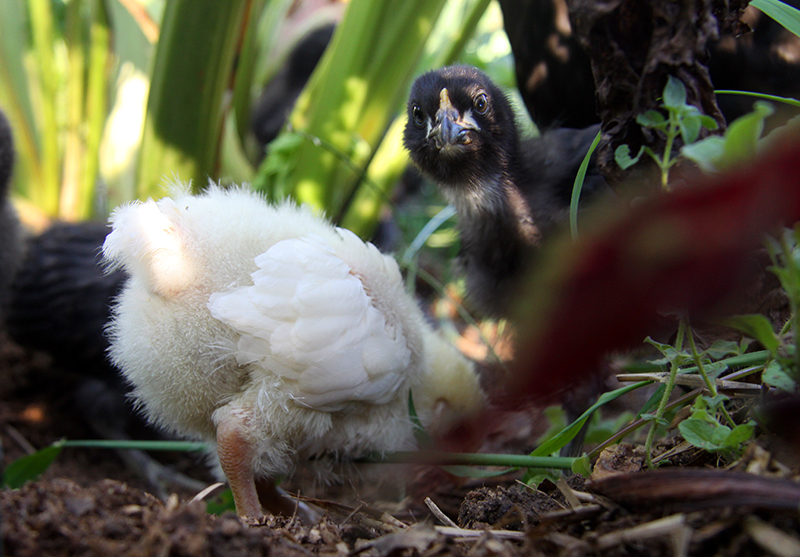
July 24th, 2013 §
The chicks are growing by the hour, and their new trick is to jump on Dahlia’s back and ride around a bit before sliding/flying off. She is amazingly patient with these constant assaults, which are probably way more cute to me than they are to her.
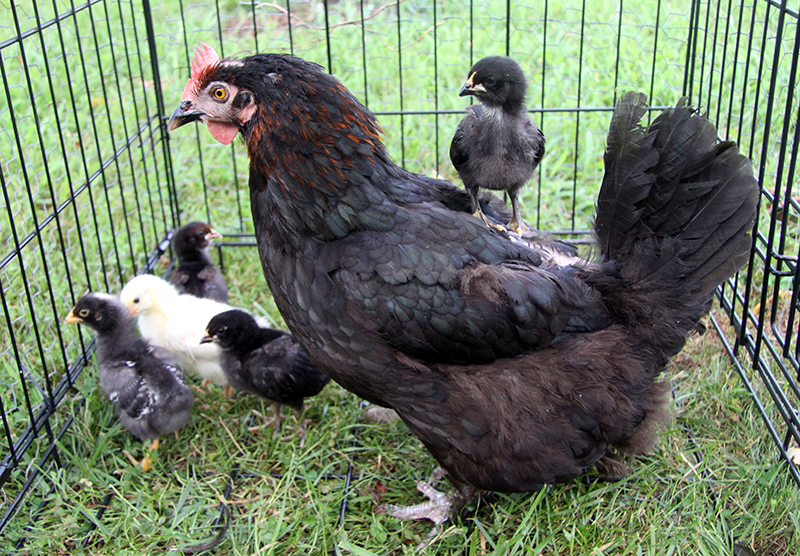
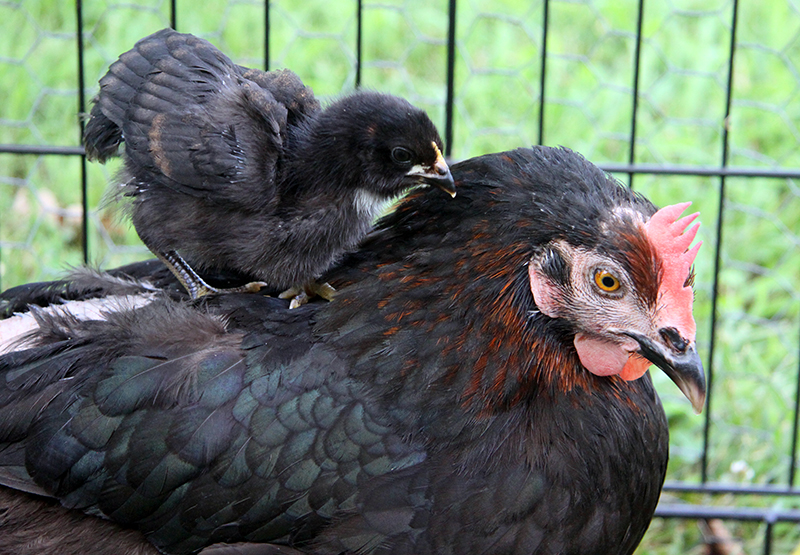

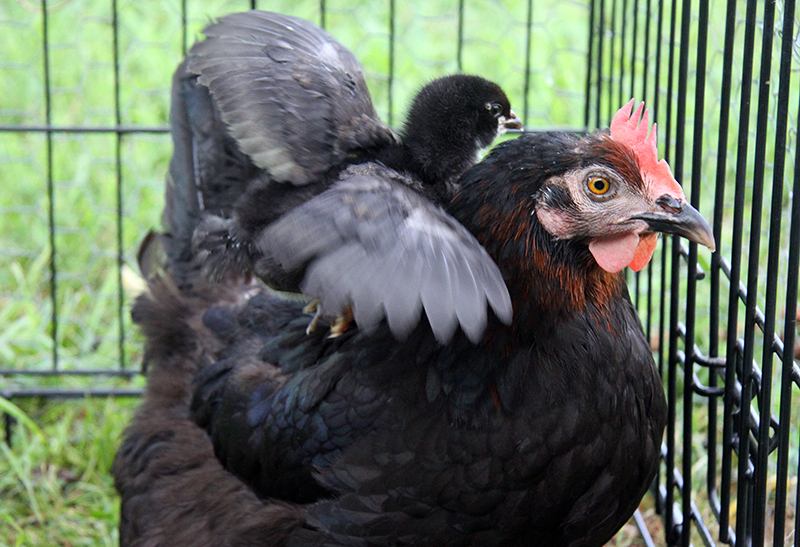
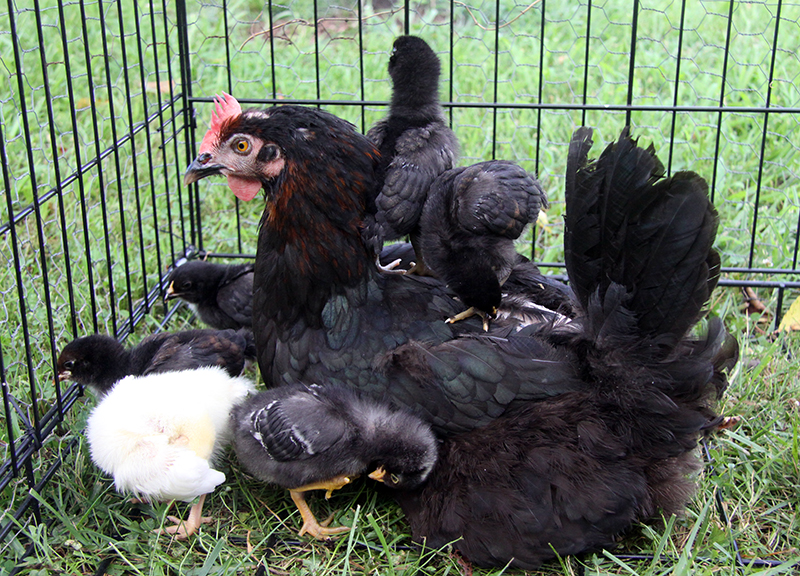
All this action shows me the chicks are ready for new adventures. On Saturday night I wrapped Tuckers’ puppy crate in chicken wire to make an escape-proof pen, and took the chicks outside for their first real exposure to grass and dirt. I’ve had then out every evening for a bit, and it’s neat to watch them learn how to scratch, hunt bugs, and eat clover. It’s amazing how much the chicks change and grow from day to day. Just two weeks old and they’re well on their way to being big chickens.


































